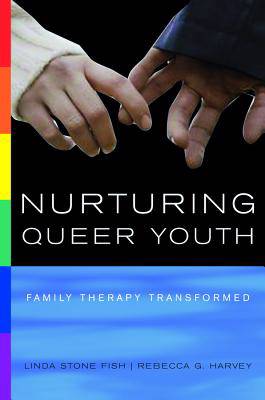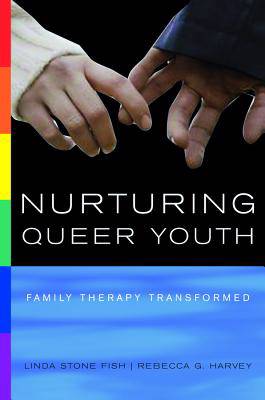
- Retrait gratuit dans votre magasin Club
- 7.000.000 titres dans notre catalogue
- Payer en toute sécurité
- Toujours un magasin près de chez vous
- Retrait gratuit dans votre magasin Club
- 7.000.000 titres dans notre catalogue
- Payer en toute sécurité
- Toujours un magasin près de chez vous
Nurturing Queer Youth
Family Therapy Transformed
Linda Stone Fish, Rebecca G Harvey
Livre relié | Anglais
27,95 €
+ 55 points
Description
This burgeoning population of sexual minority youth, along with their families, is looking for help from therapists in order to manage the stresses of late childhood and adolescence.
Nurturing Queer Youth provides therapists and other mental health professionals with the insight and guidance to assist these families. By integrating complex ideas about sex, gender, and identity, Stone Fish and Harvey go beyond accepting queer youth, to appreciating the gift that queer youth have to offer, not despite their identity, but because of it.
As youth come out at younger ages, the process of identity development is necessarily a family process and therapeutic work undertaken to address sexual identity must involve the family. Despite this fact, as well as decades of research indicating that sexual minority status is a normal variation on a continuum of sexual identities, the field of family therapy has not contributed a family model that nurtures queerness. Stone Fish and Harvey recognize this disjunction between available therapeutic models and the actual needs of clients. Drawing on data from developmental research, the concepts of queer theory, as well as their own extensive clinical experience as family therapists, the authors develop an effective model of family therapy that nurtures queer youth and their families.
The key processes of the model are creating refuge, fostering difficult dialogues, nurturing queerness, and encouraging transformation. Each therapeutic process is addressed in a single chapter which articulates the basic concept of the process, presents the research supporting the importance of the process, and then shows how to put the process into action in the therapeutic context. In the course of developing and illustrating these four key processes for helping queer youth and their families, Stone Fish and Harvey introduce readers to five families whose experiences of learning to nurture their queer youth are basic to the therapeutic lessons presented here. The approach is, above all, one that is sensitive to the specific dynamics of individual families and respectful of the challenges that all family members must face and overcome in the course of nurturing each individual's gifts as well as the gifts of the family unit. The families, whose stories readers will follow from chapter to chapter, are as much teachers as they are students in the collaborative family therapy presented with such vividness and narrative force by the authors.
Nurturing Queer Youth is a book for all family therapists and mental health professionals. This transformative approach to family therapy will enhance clinical work with all families because the model challenges cultural and familial assumptions that are harmful to all intimate relationships. Today every therapist needs to be familiar with how sexual identity issues present in the family context, and how to work with queer youth and their families toward a family dynamic that is positive and nurturing of queerness. Therapists who specialize in treating sexual minority youth will also profit from having an effective guide to conducting family therapy, including a relational map to family dynamics and ideas for intervention.
Nurturing Queer Youth provides therapists and other mental health professionals with the insight and guidance to assist these families. By integrating complex ideas about sex, gender, and identity, Stone Fish and Harvey go beyond accepting queer youth, to appreciating the gift that queer youth have to offer, not despite their identity, but because of it.
As youth come out at younger ages, the process of identity development is necessarily a family process and therapeutic work undertaken to address sexual identity must involve the family. Despite this fact, as well as decades of research indicating that sexual minority status is a normal variation on a continuum of sexual identities, the field of family therapy has not contributed a family model that nurtures queerness. Stone Fish and Harvey recognize this disjunction between available therapeutic models and the actual needs of clients. Drawing on data from developmental research, the concepts of queer theory, as well as their own extensive clinical experience as family therapists, the authors develop an effective model of family therapy that nurtures queer youth and their families.
The key processes of the model are creating refuge, fostering difficult dialogues, nurturing queerness, and encouraging transformation. Each therapeutic process is addressed in a single chapter which articulates the basic concept of the process, presents the research supporting the importance of the process, and then shows how to put the process into action in the therapeutic context. In the course of developing and illustrating these four key processes for helping queer youth and their families, Stone Fish and Harvey introduce readers to five families whose experiences of learning to nurture their queer youth are basic to the therapeutic lessons presented here. The approach is, above all, one that is sensitive to the specific dynamics of individual families and respectful of the challenges that all family members must face and overcome in the course of nurturing each individual's gifts as well as the gifts of the family unit. The families, whose stories readers will follow from chapter to chapter, are as much teachers as they are students in the collaborative family therapy presented with such vividness and narrative force by the authors.
Nurturing Queer Youth is a book for all family therapists and mental health professionals. This transformative approach to family therapy will enhance clinical work with all families because the model challenges cultural and familial assumptions that are harmful to all intimate relationships. Today every therapist needs to be familiar with how sexual identity issues present in the family context, and how to work with queer youth and their families toward a family dynamic that is positive and nurturing of queerness. Therapists who specialize in treating sexual minority youth will also profit from having an effective guide to conducting family therapy, including a relational map to family dynamics and ideas for intervention.
Spécifications
Parties prenantes
- Auteur(s) :
- Editeur:
Contenu
- Nombre de pages :
- 272
- Langue:
- Anglais
Caractéristiques
- EAN:
- 9780393704556
- Date de parution :
- 17-03-05
- Format:
- Livre relié
- Format numérique:
- Genaaid
- Dimensions :
- 168 mm x 244 mm
- Poids :
- 594 g







